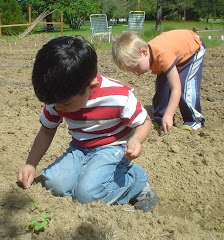by Chris Burns
 |
| Just like snow flakes, you'll never find two that look exactly
alike, attesting to Nature's infinite variety of expression! |
Have you ever seen these beautiful beans for sale at
any market? Would you even know what they were if I didn't tell you?
Don't they look like some kind of 'Magic Bean' that Jack of 'The
Beanstalk' fame might have planted? If you haven't guessed by now, I'll
tell you. They're
Scarlet Runner Beans and they're called that for two good reasons.
One, they have the
most intensely scarlet red flowers, and
Two,
they 'run' up any pole, tree, fence or trellis that happens to be close
to where they are growing. If you've never grown them then maybe it's
time to consider giving them a place in your garden.
I've
grown them many times before, but up until recently I always considered
them to be strictly 'ornamental'. Don't know why! Perhaps it's
because they were described that way in the catalog from which I ordered
my first seeds. As you can see in the pictures posted with this
article, they add exquisite beauty to any garden patch. It wasn't until
2011 that I sampled them as cooked, dried beans and discovered their beauty is only rivaled by their delicious flavor!
 |
| Scarlet Runners vining up the bamboo trellis. We grew a 70-foot row last year and are doubling it in the 2013 season. |
These beauties grow steadily to a dramatic height of
10-12 feet (or more) and need a sturdy trellis of some sort to support
the weight of their generous profusion of bean pods (we used bamboo
poles tied to a wire pulled taught between t-posts). For those who enjoy
attracting pollinators to your garden, you'll likely find (as we did)
that the flowers regularly attract hummingbirds and many beneficial
insects. (If you have cats, best not to grow the
runners as we've heard sad tales of hummingbirds being caught and killed by those furry, domestic predators).
 |
| Bean-trellis made with bamboo poles wired to a cable. |
 |
| Scarlet Runner Beans will grow in a greenhouse too. Just be sure to leave enough vents open to allow pollinators to come and go. |
 |
| Plant beans 4"-6" apart and 1"- deep. Soil can be course and should stay moist but not too wet as seeds germinate. Often we will pre-sprout the seeds by keeping them between wet towels for several days till they germinate. Be very careful when planting as the sprouts are fragile. |
The pods are
deliciously sweet when they are young and tender (about 3-4 inches
long). So sweet, in fact that it was the first thing our two teen-age
garden-helpers would seek out and munch on whenever they came to the
gardens.
 |
| Bean pod-loving teens! |
If
it's mainly green beans that you're looking for though, it's probably
best to grow another variety like 'Blue Lake' or 'Contender' which
provide you with more of a volume at each picking. These Scarlet
Runners tend to produce pods steadily over a longer season but they
become tough and stringy if they aren't picked on the small side. The
reason they probably aren't grown commercially for dried beans is that
they must be hand-picked. At the Sharing Gardens we've turned this
limitation into an asset as the weekly bean-picking was a task that
folks with back and knee-issues could accomplish easily standing up.
After a few days laid out on screens in the greenhouse the husks were
dry enough to split open easily by hand. This was a task that many
volunteers (share-givers), who weren't able to do more strenuous tasks,
found
fun and relaxing; it also provided an opportunity to sit in the shade
and chat with new found friends.
 |
| Pods, any bigger than this and they're too tough to eat green. |
If it's dried beans you
want, don't pick the pods until they are evenly tan and dry. If picked
too green, beans won't store well, nor will they be viable for planting
next
year's crop. Once the frost hits, beans will no longer ripen much more.
Pull up the whole vine and let the beans finish ripening in a
green-house or warm, dry place before picking them off the vines. When
they are as dry as they're going to get, shell these partially ripe
beans and use them first as they won't store as well as fully cured
beans.
These beautiful beans are rather large
--about the size of a fat Lima
bean-- and therefore yield enough to make a pot of soup-beans in a short
time. If you're serious about growing your own protein-source, Scarlet
Runners make an excellent choice.
 |
| Harvest beans once their pods are tan and dry. OSU-students shelling Scarlet Runner Beans. |
 |
| Shelling beans from their pods is a fun activity for all! Jim and Adri shelling kidney beans. |
But the
best kept secret of all is just how delicious
the
dried beans are. They have a mild flavor and, unlike Fava beans,
their skin is thin (not even noticeable) and they have a velvety
texture.
 |
| A bamboo tipi provides a trellis for beans and beautifully frames our garden helpers. |
Recipe: To cook these beans for eating, soak them over night
just like you would any other, with about 1/3 beans to 2/3 water in a
stainless or cast iron pot. Pour off the water the next day; rinse the
beans with fresh water and put them back in the pot. Add fresh water
until the level is about 2-3 inches over the beans.
Don't add any salt
because it won't allow the beans to absorb the water as they cook and
they'll never soften. I like to cook them on the woodstove in the
winter. These beans stay very firm when they're finished cooking but
can be easily mashed and used as refries, or made into a hearty chile
with tomatoes, onions, peppers and Mexican spices. I cook up a large
pot at a time and, once rinsed and cooled, I pack them into smaller
zip-lock bags which I stack in the freezer to add to stir-fried kale and
leeks with potatoes all winter long. Instant dinner!
Be
creative! Sometimes just a plain ole' bowl of beans with olive oil, soy
sauce, finely chopped onions and grated cheese is all you need to get
you in the mood to go outside and brave the winter elements.
 |
| Such beauty! |
Anyway,
if you want to enjoy these wonderful and versatile garden gems, the
time to plant is coming up soon! (late May or first week of June in our region) If
any of our local readers need seed please let us know and we'll get
you started, and you can save your own for next year. Happy Gardening!
To see other "How To" articles, go to our new and improved site:
http://thesharinggardens.blogspot.com/
 |
| Caleb loves scarlet runner-beans! So sweet, when they're young and tender. |




















































